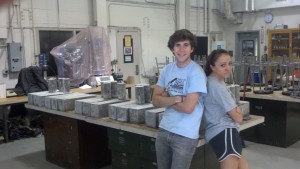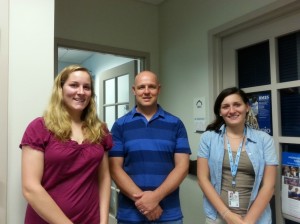Project: MUSE – Determination of Optimum Surface Profile for Bond of Fiber Reinforced Polymer to Concrete
Advisor: Dr. Andrew Bechtel
Students: Patrick Waite and Alyssa DeSimone
The goal of the research project is to determine the optimum surface profile for bond of fiber reinforced polymer (FRP) to concrete. The first step in experimental program is to make and cure the concrete beams. Once all the concrete beams are cured, their surface profiles will be altered. The surface profiles for concrete are measured on a scale from 1 to 9. CSP-1 (concrete surface profile specified by the International Concrete Repair Institute) is the smoothest concrete surface and CSP-9 is the roughest concrete surface. For the preliminary tests 12 of the concrete beams will be used. Beams will either have no surface preparation or be prepped to CSP-1, CSP-5 and CSP-9. Three beams will be tested at each surface preparation. FRP will then be bonded to the concrete surface. The average bond strength will be determined using the test set-up displayed in the figure. The data from these tests will then be analyzed to determine what surface profile showed the highest average bond strength. Based on the preliminary results 9 concrete beams with surface profiles adjacent to the preliminary surface profile showing the highest bond strength will be tested. The surface profile which displays the highest average bond strength will be determined the optimum surface profile.
Project: MUSE- Regional Calibration of the Peak Flow Coefficient for the NRCS Dimensionless Unit Hydrograph Equation for the State of New Jersey
Advisor: Dr. Michael Horst
Students: Emily Hennessy and Stella Karcnik
Civil Engineering Students Emily Hennessy and Stella Karcnik under the guidance of Dr. Michael Horst are completing a research project devoted to improving peak flow estimates resulting from various design storms over watersheds located in the state of New Jersey. They will be using historical data to calibrate parameters associated with the Natural Resources Conservation Services “Dimensionless Unit Hydrograph Method”. The NRCS method is the most widely utilized method, by the engineering community, for hydrologic analysis of watersheds. The method allows for prediction of both the peak flow and volume of water resulting from any given precipitation event, both of which may be used as part of the design process for various hydraulic structures such as bridges, culverts and dams.
Project: Characterizing Motorist Cell Phone Use at Signalized Intersections
Advisor: Dr. Tom Brennan
Students: Jhenifer De Araujo, Yasmine Silva, Pedro Furlanetto, Ricardo Alves, Lucas Marini, and Liliane Costa
Civil Engineering Professor Tom Brennan and Visiting Electrical Engineering Professor Joe Jesson are collaborating on a transportation research project to characterize cell phone use at signalized intersections. With the assistance of six undergraduate student researchers from Brazil (left to right: Jhenifer De Araujo, Yasmine Silva, Pedro Furlanetto, Ricardo Alves, Lucas Marini, and Liliane Costa), the professors are developing an automated methodology to identify and document driver cell phone use in moving vehicles. The research is being presented at the Intelligent Transportation Society of America (ITS) World Congress in September.
Dr. Thomas Brennan is also working on a University Transportation Research Center grant to evaluate the spatial impact of recurring Travel Time Reliability along I-80 in New Jersey.



